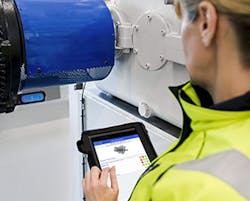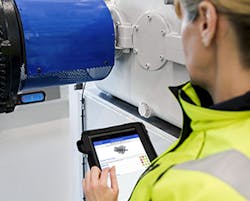In this article:
- Fail to plan...plan to fail
- Data collection: Permanent vs. portable sensors
- Collecting and leveraging data
A typical industrial plant, whether a steel mill or a food manufacturing facility, may have dozens of rotating equipment assets, such as motors, gearboxes, pumps, and fans. Some of these assets may be designated as critical to the operation, whereas other noncritical assets may be considered “balance of plant” equipment, where a failure can result in nuisance delays, unplanned maintenance, and additional costs.
It’s commonly accepted that when working with rotating equipment, reactive maintenance can be five to seven times more expensive than planned maintenance and have a higher safety incident rate, as well. Unexpected equipment failure can force companies to expedite parts that may not be in inventory and/or pay overtime for personnel to play production catch-up. Moreover, it creates the risk of affecting customer service from a lack of product availability.
Fail to plan...plan to fail
Plant personnel who fail to properly implement proactive maintenance techniques often find themselves in reactive mode. When a crisis occurs, maintenance staff must focus their attention and resources on a specific piece of equipment, sometimes at the expense of other machinery. This can put manufacturers in perpetual catch-up mode, leading to loss of productivity and profits. On the flip side, overmaintaining equipment can lead to wasted money and resources – this is traditionally where a PM optimization may be recommended.
So, how do you strike a balance? In today’s competitive marketplace, more manufacturers are beginning to implement condition monitoring and predictive maintenance to help avoid unplanned downtime and improve overall equipment effectiveness on the plant floor. Maximizing productivity involves more than just conducting routine maintenance – it requires using condition monitoring tools such as smart sensors connected to mobile apps to help plant managers promptly predict machinery issues before they affect operations. From a reliability perspective, looking at this on a P-F curve [showing potential failure (P) to failure (F)] using these new technologies will help you identify these potential premature failures and mitigate them before they start manifesting themselves as audible noise and heat-related issues.
Avoiding machine breakdowns with the help of new technologies can result in significant improvements in plant performance. However, implementing predictive maintenance can be a daunting task. Concerns about capital expenditures and training personnel on how to use and manage these tools are real barriers to entry. However, portable, wireless condition monitoring tools and mobile platforms can offer a lower cost of entry for predictive maintenance. There are many wireless condition monitoring tools currently on the market; these vary greatly in both cost and complexity. Understanding what to look for can provide plant maintenance staff with an easy-to-use, cost-effective method to help get them get started in preventing rotating equipment failure.
Data collection: Permanent vs. portable sensors
Wireless sensors that measure vibration, temperature, and other variables may be built into a rotating asset or permanently mounted on a piece of equipment. More and more plant reliability professionals are asking that these sensors – often used for critical rotating assets where continuous monitoring is required – be retrofitted during gearbox rebuilds. These sensors, however, are capable of supporting only the specific asset into which they’re built or onto which they’re attached. In addition, using permanent sensors for balance-of-plant equipment may not be cost-effective for the dozens of rotating equipment assets on the plant floor.
To help alleviate these cost barriers, some manufacturers have developed inexpensive yet sophisticated portable wireless sensors that work in conjunction with a mobile app, allowing plant personnel to quickly capture and store data. These sensors capture equipment data readings such as velocity, acceleration, and temperature – key indicators for identifying problems.
Collecting and leveraging data
While portable wireless sensors can help companies overcome cost barriers for collecting data, another hurdle is the ability for workers to interpret that data and properly diagnose problems – especially as less-experienced workers join plant teams. Some wireless sensors are paired with a mobile app that operates from a smartphone or tablet. These apps resonate well with the next generation of employees. However, to be effective, it’s important for the app to have an intuitive, user-friendly interface that requires no additional training for employees to set it up and use it.
Josh Flemming is director of strategic market digital transformation at SKF. He has more than 15 years of experience in sales and business development for distribution and manufacturing.
Paul Craven, CFPHS, is service shop branch manager at Motion Industries’ repair shop in Pensacola, FL with a special focus on reliability-centered maintenance (RCM). He is certified by the International Fluid Power Society as a fluid power hydraulic specialist and has worked in the field for more than 25 years.
Machine operators are the most familiar with their equipment and typically outnumber maintenance technicians 10 to 1 – they can be great place to start to implement this to complement an operator basic-care program. They also typically help identify improvement-based work and generate the bulk of the work orders for minor and major repairs. At least 50% of your down-day work should be dedicated to improvement-based maintenance.
A good app should also allow maintenance technicians to quickly enter information for the rotating equipment size, platform flexibility, and bearing bore and speed. Once the equipment assets are entered, there may be several ways to set parameters for data collection. Look for an app that calculates alarm thresholds based on ISO standards in conjunction with user-provided asset data but that also allows more-experienced technicians to set custom thresholds and alarms for each machine as required.
The ability to share asset data is also important. This allows plant personnel across various shifts to exchange information easily with each other, without having to reload assets into the app. In addition, the app should allow users to quickly share that data with experts who can properly interpret the data and provide recommendations for a solution.
Finding an affordable, user-friendly sensor and mobile app solution is an ideal way to begin monitoring machine health and quickly identify equipment issues before operations are affected. All equipment must be maintained at some point. Today’s portable wireless sensors and mobile apps offer the flexibility to proactively monitor rotating equipment and share data with key personnel, whether it’s the maintenance team on another shift, a parts distributor who can be ready with necessary spares, or diagnostics experts who can provide recommendations when needed for difficult applications.

